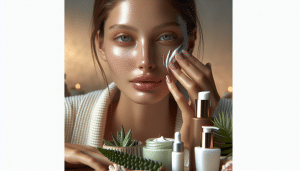Unlocking Glowing Skin Secrets You Can Try
Natalie Brooks September 14, 2025
Discover the essentials of radiant, healthy-looking skin with insights into modern skincare routines and natural beauty strategies. This guide explores affordable ways to support skin wellness, demystifies product choices, and shares lifestyle tips for lasting beauty—making glowing skin feel truly accessible.
Understanding Radiant Skin and Its Importance
Radiant skin is often interpreted as a marker of health, wellness, and self-confidence. When discussing glowing skin, people might picture a smooth, clear complexion with an inner luminosity that goes beyond makeup. This type of skin is achieved through balanced skincare regimens, hydration, and smart lifestyle habits. While genetics play a role, everyone has opportunities to enhance their natural beauty. Even simple changes in routine can make a real difference. Many people turn to research-backed practices for clearer, brighter skin instead of quick fixes.
Skincare isn’t just about application—it often involves understanding the unique needs of your own complexion. Factors like skin type, environmental stressors, and age can affect the skin’s overall glow. Tailoring cleansing, exfoliation, and moisturizing steps to individual requirements ensures maximum benefit and comfort. For example, people with oily skin might focus on oil control and lightweight hydration, while dry skin benefits from richer, more emollient products. Knowing your skin’s needs helps you pick routines that foster radiance from within.
Committing to skin health isn’t solely a cosmetic pursuit. Glowing skin can reflect underlying wellness, such as proper nutrition, robust sleep habits, and stress balance. Scientific studies suggest external appearance can serve as an indicator of internal health challenges or deficiencies (Source: https://www.cdc.gov/aging/publications/index.htm). Radiance often comes from supporting both inner health and the skin’s barrier with intentional care, patience, and gentle products.
Building a Personal Skincare Routine for Results
Selecting an effective skincare routine doesn’t require an overwhelming number of steps. Most experts recommend a foundation consisting of cleansing, moisturizing, and consistent use of sunscreen. This trio protects the skin from pollutants, dryness, and UV damage, which are leading contributors to premature aging and dullness. High-EPC skincare concepts like ‘serum layering,’ ‘double cleansing,’ and ‘barrier repair’ have become popular because they address multiple concerns at once. Many dermatologists offer guidance on how to select steps that truly support glowing skin over time (Source: https://www.aad.org/public/everyday-care/skin-care-basics/care/skin-care-basics).
Routine consistency is critical for visible improvement. Using cleanser and moisturizer both morning and night can help maintain a balanced complexion. Adding targeted treatments, like retinol or vitamin C serums, addresses specific concerns such as uneven tone or fine lines. Over-exfoliation or jumping between products may upset your skin’s equilibrium, leading to irritation. Gentle, gradual adjustments often produce better results than rapid, dramatic changes. Remember that patience supports healthier, more resilient skin over the long run.
Customization is the heart of any practical skincare approach. For sensitive skin, fragrance-free and hypoallergenic products reduce the risk of reactions. People with acne-prone complexions frequently benefit from non-comedogenic formulations and ingredients like salicylic acid. Meanwhile, those seeking enhanced hydration may explore the benefits of hyaluronic acid or ceramide-based creams. No matter your skin type or concern, the right combination of reliable basics and thoughtfully chosen extras can unlock your glow potential.
Harnessing Nutrition and Lifestyle for Skin Wellness
Good nutrition and lifestyle choices play an essential role in achieving luminous skin. Research indicates that antioxidants found in fruits and vegetables—think berries, oranges, leafy greens—help protect skin cells from oxidative stress and inflammation (Source: https://www.hsph.harvard.edu/nutritionsource/antioxidants/). Water intake supports hydration, making the skin appear plumper and more supple. It’s also important to manage sugar and highly processed food intake, as these can sometimes contribute to breakouts or skin dullness.
Alongside nutrition, physical activity and stress management techniques have become recognized for their influence on skin health. Movement boosts circulation, ensuring that oxygen and nutrients reach the skin’s deeper layers. Practices such as yoga, mindful breathing, or even simple stretching sessions can improve relaxation and help support the body’s natural healing processes. Adequate sleep, too, is vital for skin recovery, allowing the cells time to renew and repair overnight.
Making wellness a habit doesn’t require drastic diet changes or intense exercise routines. Small, sustainable adjustments—like adding a serving of vegetables to daily meals or establishing a consistent sleep routine—are proven to foster lasting changes. The cumulative effect often appears as increased brightness and comfort in the skin. Balanced life choices nourish not just the complexion but also overall well-being, helping to maintain beauty that comes from within.
Exploring Natural and Gentle Beauty Solutions
Natural beauty solutions resonate with many individuals who value minimalism or wish to avoid harsh chemicals. Ingredients such as aloe vera, green tea extract, and oatmeal are frequently featured in calming masks or cleansers for their ability to soothe irritation and support the skin barrier. Recent trends highlight the move towards ‘clean beauty,’ emphasizing transparency, sustainable sourcing, and gentle formulations (Source: https://www.ewg.org/skindeep/).
Layering gentle botanicals and antioxidant-rich extracts can deliver noticeable improvement without overwhelming sensitive skin. Calendula, chamomile, and centella asiatica are praised for promoting comfort and resilience. Using facial oils—especially those containing omega-rich seed oils—can help balance the skin’s natural moisture barrier. For anyone seeking simplicity, these approaches limit ingredient overload while supporting a luminous complexion through nature’s own solutions.
It’s important to note that not every natural remedy is a fit for every skin type, and some can provoke allergies. Those interested in natural skincare are encouraged to patch-test new ingredients and consult dermatology sources for scientific insights on their efficacy. Trusted nonprofit resources and dermatologist-led organizations often provide guidance on natural ingredient safety and their appropriate use in beauty routines, making exploration safer and more informed.
Debunking Myths and Avoiding Common Skin Mistakes
There are plenty of myths around skincare that can complicate the pursuit of healthy, glowing skin. For instance, common misconceptions like “more product means faster results” or “expensive equals effective” frequently lead to disappointment. Evidence-based resources recommend focusing on formulation quality, consistency of use, and realistic timelines over advertising hype or peer trends (Source: https://www.fda.gov/cosmetics/cosmetic-products/skin-care-products).
Troubles can also arise from skipping sunscreen or using unproven home remedies. Sun protection is consistently ranked as one of the most impactful practices for preserving skin health and vibrancy over time. Many leading skincare professionals suggest that using daily broad-spectrum SPF not only defends against visible aging but also supports overall skin clarity and smoothness. Meanwhile, applying kitchen staples (like lemon juice or baking soda) directly to the face can disrupt delicate pH balance or trigger irritation.
Individuals interested in improving their skin may be tempted by internet trends and viral ‘miracle’ cures. However, critical evaluation and reliance on comprehensive health and wellness guides, rather than anecdotal tips, ensure safer and more satisfying results. Always gravitate toward reputable dermatology, public health, and wellness sources for advice that stands up to scrutiny. This approach protects your skin and helps you avoid costly pitfalls along your beauty journey.
Adapting to Skin Changes Across the Lifespan
Skin will continually change in response to age, environment, and health status. As the years pass, common adjustments include reduced elasticity, increased dryness, or shifting oil production. Recognizing and respecting these transitions enables better care and targeted support. Instead of seeking a ‘fountain of youth,’ experts encourage a thoughtful approach that meets the skin’s evolving needs (Source: https://www.niams.nih.gov/health-topics/skin-care).
In youth, breakouts or sensitivities may be the primary focus, while mature skin often finds benefit in nourishment and moisture retention. Those navigating midlife changes might explore serums with peptides or gentle retinoids for supportive results. Regardless of age, embracing protective measures—like shade, hydration, and restorative sleep—offers consistent rewards in preserving radiance and comfort. Even seasonal changes call for a revision of routine, prioritizing hydrating or barrier-supportive steps in drier or colder weather.
Embracing the process of natural change allows for aging with optimism rather than urgency. Building practices that honor your skin at each stage leads to confidence and acceptance, whether you are just beginning a beauty journey or refining established rituals. Supported by ongoing research and adaptable guidance, everyone can discover realistic strategies to glow through each stage of life.
References
1. Centers for Disease Control and Prevention. (n.d.). Healthy Skin Reports. Retrieved from https://www.cdc.gov/aging/publications/index.htm
2. American Academy of Dermatology. (n.d.). Skin Care Basics. Retrieved from https://www.aad.org/public/everyday-care/skin-care-basics/care/skin-care-basics
3. Harvard T.H. Chan School of Public Health. (n.d.). Antioxidants. Retrieved from https://www.hsph.harvard.edu/nutritionsource/antioxidants/
4. Environmental Working Group. (n.d.). Skin Deep Database. Retrieved from https://www.ewg.org/skindeep/
5. U.S. Food and Drug Administration. (n.d.). Skin Care Products. Retrieved from https://www.fda.gov/cosmetics/cosmetic-products/skin-care-products
6. National Institute of Arthritis and Musculoskeletal and Skin Diseases. (n.d.). Skin Care and Aging. Retrieved from https://www.niams.nih.gov/health-topics/skin-care








